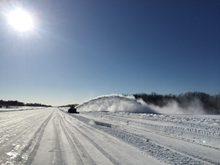
Features
Profiles
Snow clearing at small municipal airport demands the right equipment and approach
May 6, 2016 By Mike Jiggens
IN a small community like Parry Sound, Ont., the airport is more than just a transportation terminal. As general manager of Parry Sound Municipal Airport, it’s Neil Pirie’s job to keep the facility “open for business” for a wide range of activities and enterprises.
As well as providing aviation service for cottagers and business flyers, Pirie is also accountable for serving the business park that also shares the site and for maintaining the region’s link to vital emergency services.

In winter, it can be a daunting task. Located on the eastern shore of Georgian Bay, Parry Sound is in the path of frequent “lake effect” snow squalls—localized blizzards that form suddenly over Lake Huron and quickly blanket the area in heavy snow.
“It’s not unheard of for us to come in here and have to move a foot and a half of snow,” Pirie reports. “The squalls can park right on top of us for 10 days straight, leaving us with another eight inches of snow every day. With the equivalent of 16 acres of roadways and parking areas that need to be cleared, all we can do is get out and peel off the layers as quickly as we can, sometimes in zero visibility.”
Multiple tasks on one site
When the snow hits, Pirie’s day will typically start at 5:30 a.m. to clear parking areas and access roads for the Parry Sound Airport Business Park so that those businesses can start work by 7 a.m. Next, the roads and areas around the aviation shops are cleared by 8 a.m. Then, they move to the lanes and parking for the terminal itself, including the café and fuel pad. Finally, the runway and taxi areas for the aircraft.
“It’s not just the air side we have to worry about. The companies on the field here have about 70 employees in the Business Park that have to keep working. This means that all aspects of the airport need to be functional.”
Until two years ago, clearing the snow there required a crew of three operating a street plow, a half-ton truck and a Ford 8700 tractor fitted with an 8-foot snow blower. Then Pirie and members of the Parry Sound Airport Commission brought in a new system in time for Christmas. Two new power units came into the fleet: both New Holland TV 145 tractors. One tractor was equipped with a 15-foot HLA SnowWing and the other with a 10-foot 6120RH double-auger snow blower from Reist Industries.
Special needs on runways
“When the committee from the Airport Commission was researching the equipment, we knew we needed a more powerful tractor, at least 130-horsepower, and we needed a more robust snow blower. When a weather event moves in on you, you have to be able to move through all kinds of ice chunks and heavy snowbanks that have been piled up. In some cases, the windrows have to sit a while and they can freeze over. You’re never done. You have to keep going to try and keep up. We really needed a blower that could get in there and chew through everything and blow it clear away!
“Cleaning an airport is not like doing a parking lot. You can’t pile the snow just anywhere. In our situation, you can’t have high windrows and snow banks. So, you have to blow the snow off. Some of the aircraft come in with wings just four feet off the ground.
“We have a 75-foot wide, 4,000-foot runway. We have to move the snow to the lights first, and then blow it over the lights and out of the way. The blower is the most important piece of equipment at this airport, or we would have nowhere to put the snow.”
Done in half the time
Pirie is more than satisfied with the performance of the new fleet. Side chutes on the snow blower improve its efficiency when it’s running into the wind and increases its throwing distance. The bi-directional articulated tractors allow the maneuverability to run tight passes, with virtually no turning radius.
“It’s phenomenal! The new equipment has reduced, on average, our removal time by at least 50 per cent, and we’re doing it with just two crew.”
Pirie reports that timing is everything, and he is grateful to the commission for its support in acquiring the new equipment.
“Last winter was exceptional. For the complete season, we received between 18 to 20 feet of snow and, during the months of November and December, the average on a monthly basis was over 100 centimetres!”
Pirie also found the durability he was looking for in the snow blower.
“As is the case with any snow clearing equipment, we keep an eye on the cutting edge, because we have to clean right down to the asphalt; we can’t leave any ice on the runway. But we haven’t yet had to replace any parts. We have called the factory a few times just for information.”
By keeping the airport property clear of snow faster, Pirie is meeting his goal of keeping the complete facility “open for business.” And the most important business, he said, is emergency services.
“Often when we get a large snow event, there are power outages in the region. So being able to get the Hydro One helicopters fueled up and off the ground right away, to restore the power, is huge. And getting air ambulances in… I don’t know what more you have to say. If they can’t get in, it’s critical.”
Print this page